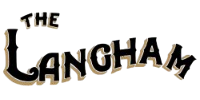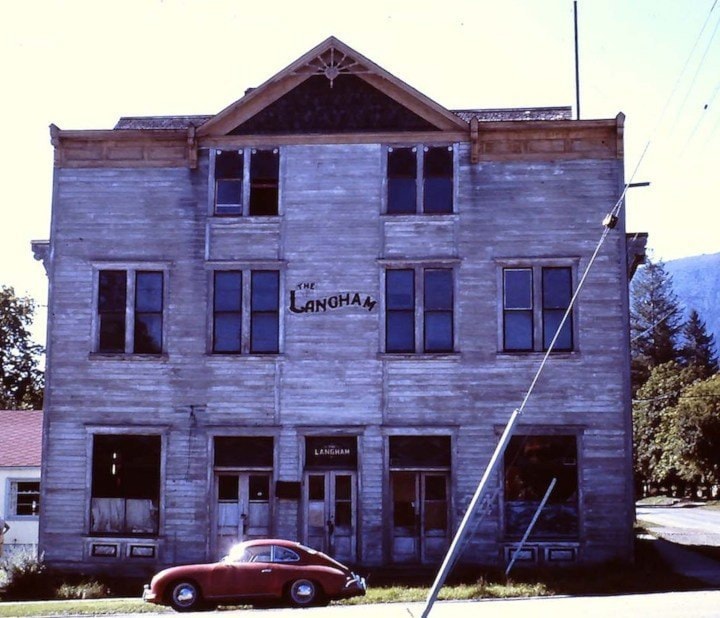Legends of the Langham, revisited
Written by Greg Nesteroff
Originally published in the Nelson Star on Jan 26, 2015
Seventh in a series
To date this series on the early years of Kaslo’s Langham Cultural Centre has looked at when it was built (1896-97), who built it (Charles J. Kapps), what became of him (married twice, moved to Spokane, ran an investment company), who he sold it to (surveyor A.R. Heyland and land agent A.J. Curle), what it was used for (bank, bottling works, rooming house, offices), and its role in the Japanese Canadian internment.
These things can be pinned down with a fair degree of certainty. But other bits — folklore, really — might never be satisfactorily resolved.
- Was the Langham ever a brothel?
According to Kaslo: The First 100 Years, published in 1993, “the upper floors were rumored to have been bases of operation for ladies of easy virtue.”
It’s hard to verify or debunk this statement, which seems like sort of thing that could be said of any old building to spice up its history. In his book Ladies of Easy Virtue of West Kootenay, the late Ken Morrow said the rumor the Langham was once a brothel is untrue, but didn’t explain how he reached that conclusion.
Kaslo’s red light district was centered around Third Street and A Avenue, two blocks from the Langham. It was also on A Avenue that the Theatre Comique stood, a combination variety theatre and bar where waitresses known as box rustlers preyed on thirsty miners. They may or may not have been prostitutes, but their morality was certainly questioned.
One longtime Kaslo madame, Maggie Clifton, was mentioned in the Nelson Tribune of June 19, 1897 as laying a complaint of abusive language against Alice Merchant, who was fined $20 “for the too free use of her tongue.”
Clifton turns up on the 1901 census as a “lodging house keeper,” although the exact location of her brothel is unknown. Her staff included Jennie St. Clair, musician; Marjorie Adams and Clara Johnson, dressmakers, and Dorothy Stewart, chambermaid. These professions might have been euphemisms, or they could have been ways the women supplemented their incomes. Nearby, another lodging house keeper, Nellie Howard, lived with dressmaker Helen DeVille.
There was less prevarication on the 1911 census, which listed prostitutes as “inmates.” At this time Clifton’s brothel was home to Mary Cooper, Rose Billington, May Jennings, Ollie Abbott, Mary Kamuri, and Martha Tighe. Nearby was the brothel of Molly Brown. Jean Brown, possibly her sister, was the only other woman working there.
A walking tour on the Kaslo Chamber of Commerce’s website suggests Molly built the house at 312 Third Street, “the last remaining of the original bawdy houses located in this area.” Molly also had a brothel in Sandon, which has been restored.
No prostitutes are obvious in Kaslo on the 1921 census, although Morrow’s book says Brown lived there until her death in 1948. The BC vital events index has no record of her passing, although that may not have been her real name.
- Was the Langham once home to the longest bar in the area and/or world?
According to Heritage Homes and Buildings of Kaslo, published in 1992: “The Langham was purported to have one of the longest bars in the area and it stretched from the front of the building right down to the back … between 80 and 90 feet!”
Similar statements have appeared in the past on the websites of The Langham & the Kaslo Chamber of Commerce, and in the Kaslo Visitors Guide: “The longest bar in the area ran from the front of the building to the back and never stopped serving.”
Where does this notion come from? The earliest reference yet found is in the Nelson Daily News of May 12, 1971: “Many historic sites greet you as you enter [Kaslo]. One of many is the Langham Hotel (not in operation), at one time boasting the world’s longest bar.”
Yet for such a long bar, the Langham may never have had a liquor license. Historian Ron Greene, who maintains a database of historic BC hotels, has no record of the Langham ever applying for one in its early years. Although there are gaps in his information, he does have listings for many other Kaslo hotels. Greene says it would have been unusual for a rooming house to be granted a license — which is what the Langham really was, although it’s sometimes referred to as an hotel. Charles Kapps, who ran the Slocan Bottling Works, did sell wholesale liquor, however.
If the Langham actually had an exceptionally long bar, what became of it? According to Michael Guthrie, who spearheaded the building’s restoration in the 1970s, “There was a bar/counter in the Langham when we took over. It’s now the counter at the Bluebelle Bistro. We kept it in the main gallery room for several years, then at some point the board at that time decided they didn’t want it.
“Photographer Gordon Brown purchased what’s now the Bistro building and got the old bar/counter from the Langham and put it there. You can see how one end is just cut off, so who knows?”
Quite a few places now claim the “longest bar in the world” title. But the one recognized by Guinness World Records is the Beer Barrel Saloon of Put-in-Bay, Ohio: 405 feet, 10 inches (123.7 m). The bar is fitted with 56 beer taps and has 160 stools.
The longest bar in Canada is a 100-foot (33 m) former teller counter at the Great Banking Hall in Toronto.
The Heritage Homes book contains another unverifiable statement: “Upstairs the rooms rented for $1 a night … bring your own bedding and furniture!” Although rates were never given, ads for the Langham in 1897-98 refer to it as “finely furnished.”
- Is the Langham haunted?
Like its London counterpart, the Langham is said to have a resident ghost.
How or when this story originated is unclear, but it’s mentioned in the Weekender of March 22, 2002 in an article headlined “Legends of the Langham.”
The details also appear on several websites, which paraphrase each other closely. This version is from waymarking.com and begins by noting the Langham housed Japanese Canadians interned in Kaslo during the Second World War.
“It was during this time that one of the little Japanese Canadian children, a 10-year-old girl, died while living in the Langham Hotel.
“It is believed that the little girl died after a fall down the stairs. She was chasing a ball, tripped and fell to her death. It is reported that her ghost is friendly in nature and no one seems to be frightened by her. She is, however, known to be a little trickster at times.
“People have heard footsteps, lights go on and off at odd times, and the sound of a ball bouncing down the stairs has also been heard.”
Even if you believe in ghosts, the Langham’s spectre must belong to someone else, for the above appears based on an actual incident that occurred at a different building. The only Japanese Canadian child who died in Kaslo during the internment was Masuye Kitagawa, whose age was reported variously as three, four, or five.
The New Canadian, a Japanese-Canadian newspaper whose operations would soon move to Kaslo, reported on September 9, 1942: “Kaslo — In a recent tragic accident here, the three-year-old daughter of Mr. and Mrs. Katahenra [sic], formerly of Timberland Mill, New Westminster, fell from the third floor of one of the buildings being used to house Japanese evacuees. The little tot died in the Kaslo Hospital a short time later.”
The paper carried a more detailed account three days later: “Four-year-old Masuye Kitagawa died September 1 at the Kaslo Hospital, where she had been taken on Saturday afternoon, August 29, suffering from injuries received when she accidentally fell from the third story window of the Kaslo Hotel. She suffered a broken left leg, cuts and bruises and internal injuries which proved fatal.
“At the time of the accident she was peering at workers fixing the dormitories below. Since the first accident which occurred in this same building, the windows had been barred to the half-way mark but for some reason only one bar had been placed in this particular room. Leaning too far over, the little girl fell head first, striking the second story and landing on a pile of lumber.”
It’s unclear what happened in the first accident referred to. Today’s Kaslo Hotel is on the same site, but was not the same building.
According to her death registration, Masuye was born to Sotojiro and Kikuye (Kimira) Kitagawa in New Westminster on June 12, 1937, which would have made her five. Dr. George Gibson indicated the cause of death was meningitis, and that she fell 80 feet (24 m). She was cremated in Spokane.
Next: Michael Guthrie’s Langham Memories
Previously: Part 6: The Langham in Wartime

